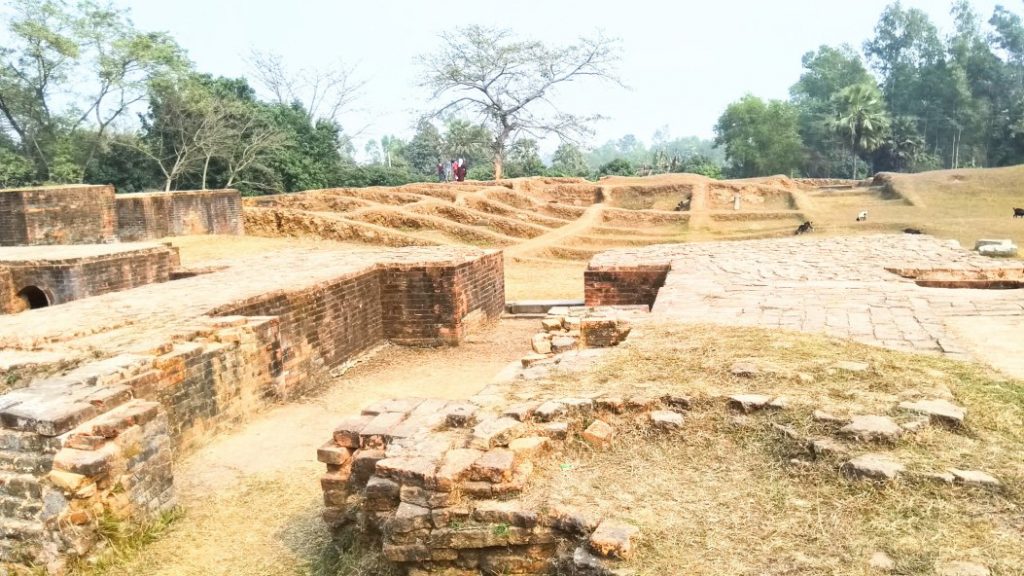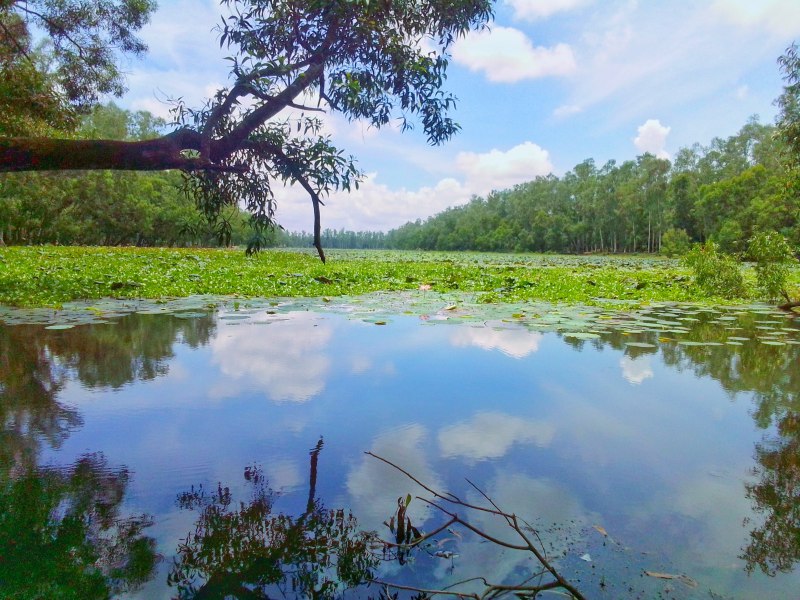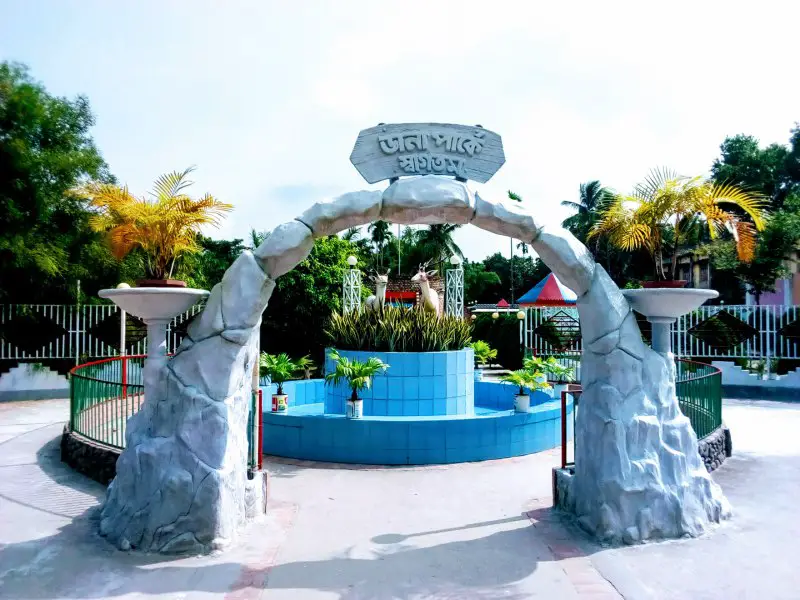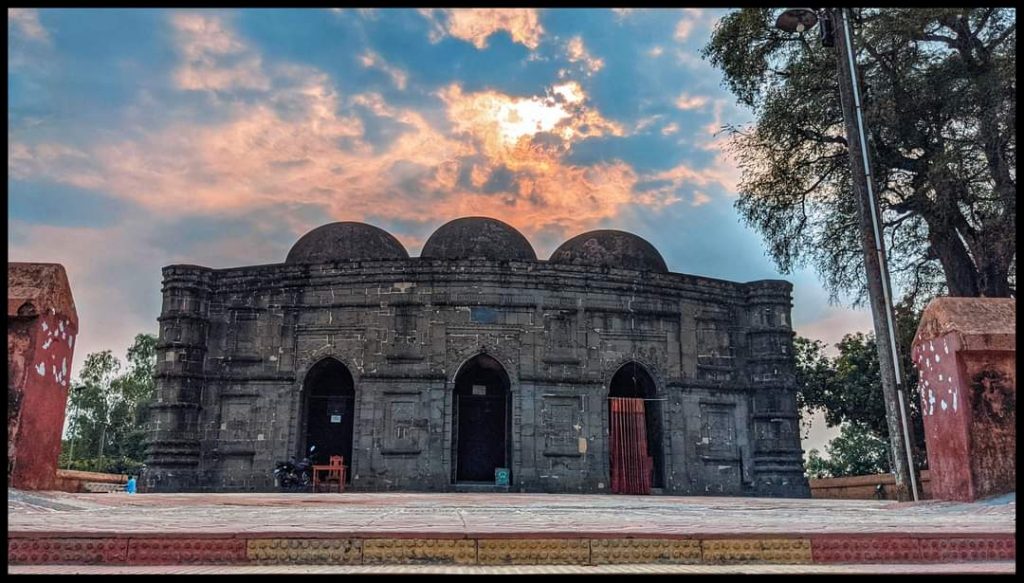In this article, we discussed the best tourist places in Naogaon to visit.
Page Contents
9 Worth Visiting Best Tourist Places In Naogaon
1.Paharpur Buddhist Vihara/Paharpur Buddhist Bihar/পাহাড়পুর বৌদ্ধ বিহার

Known as Paharpur Buddhist Vihara (Paharpur Buddhist Bihar) or Sompur Mahavihara (Somapura Mahavihara), the Buddhist Vihara is an ancient structure that is now almost destroyed.
Paharpur Buddhist Vihar has located just 10 km from Badalgashi Upazila in Naogaon district.
has located just 10 km from Badalgashi Upazila in Naogaon district.
Sri Dharmapaldev, the 2nd king of the famous Pal Dynasty, built this Buddhist Vihara in the 9th century. Sir Cunningham discovered this historic structure in 1879.
In 1985, UNESCO listed Paharpur Buddhist Vihara as a World Heritage Site. Paharpur Buddhist Vihara was known as the center of Buddhist religion for nearly 300 years.
At that time, Buddhists from Tibet, China, Malaysia, Indonesia, and Myanmar also rushed to Paharpur Buddhist Vihara to practice religion and gain knowledge.
Paharpur extends to 922 feet to the north and south of Buddhist Bihar and 919 feet to the east-west. Buddhist monks inhabited a total of 177 houses in Bihar.
In the middle of Bihar, a temple measures 400 feet long and 350 feet wide, with a height of 70 feet.
The temple’s outer walls have found goddess statues of Buddha and Hindus and several plaques of burnt clay.
The main enclosure of Paharpur Buddhist Bihar is about 20 feet wide. Another Buddhist temple can be seen inside the enclosure.
A wide boundary wall around Bihar surrounded the four-way Paharpur. There were 92 small rooms lined inside the boundary wall.
It is estimated that monks lived in all the rooms, and later some rooms were used as prayer rooms.
There is the main entrance between the northern sides of Bihar. Until 1984 there was a pond in front of the entrance.
During excavations here in 1984-85, huge silver coins of Caliph Haroon Al-Rashid’s regime were found, which are preserved in the museum adjacent to Paharpur Buddhist Vihara.
In addition, several statues, coins, inscriptions, etc., are available from Paharpur Buddhist Vihara.
People Also Read: Amazing 8 Top Tourist Attractions To Visit In Rajshahi
What is in Paharpur Buddhist Vihar
Central temple
There are ruins of the central temple in the middle of the open premises inside Paharpur Buddhist Bihar.
Amazing architectural artifacts Around 2000 terracotta plaques are found across the walls of the temple.
The main temple of 400 feet length and 350 feet width was built by mixing mud with bricks.
Bathrooms & Toilets
Many bathrooms and toilets were constructed on a platform about 27 meters from the south wall outside Buddhist Bihar.
The bathroom and toilet were connected to room 102 of Buddhist Bihar through a high barrier road.
Sandhyavati Ghat
A Sanbandha ghat can be seen in the southeast corner outside the wall of Paharpur Buddhist Bihar.
This ghat is known as Sandhyavati Ghat. It is said that Sandhyavati, daughter of King Maidalan, used to bathe in this ghat.
Open courtyard
Several destroyed buildings can be seen in the open courtyard within Buddhist Bihar. There are sporadic administrative buildings, eateries, kitchens, dedication stupas, wells, etc.
Satyapir’s Vita
The Vita of Satyapir is located 365 meters east of Paharpur Buddhist Vihara. The ruins of a Tara temple and 132 dedication piles were seen at Vita in Satyapir.
Around 50 terracotta plaques, Eight handed Devi idols, and Buddhist religious doctrine sit-ins have been found in the temple premises. There are 132 dedication piles in the temple area.
Gandeshwari Temple
Another temple can be seen just 12 meters west of Sandhyavati Snan Ghat. The temple is locally called the temple of Gandeshwari.
The length of the temple is 6.7 meters, and the width is 3.5 meters. On the southern wall of the temple is a statue of The Buddhist Goddess Padmapani and the front wall has a lotus flower design.
People Also Read: The 7 Popular Joypurhat Tourist Spots You Should See, Rajshahi
2.Divine Victory Pillar/Dibar Jayastambha/দিব্যক জয়স্তম্ভ

Dibar Jayastambha or Dibar Pillar, a symbol of Bengali nobility, is located in the middle of Dibar Dighi in Patnitala Upazila, about 33 km from Naogaon district.
Located in the spherical Dibar Dighi, the eight-cornered granite stone Jayastambha pillar is 31 feet 8 inches in height, 6 feet 3 inches underwater, and 25 feet 5 inches above the water.
The circumference of each corner of the pillar is 1 foot 3.5 inches. The upper part of the divine Jayastambha is adorned with various carvings of grooved crowns.
Situated in the picturesque surroundings, this spectacular Jayapillar has become known to the locals as one of the most spectacular places.
History
Debor Dighi, excavated during the Pal dynasty, spread over about 60 bighas of land, is also known to the locals as the Karmakar reservoir.
The Dighi, which has a ghat, has paddy land and high green mounds.
Jayapillar was built by cutting an unbroken stone in the middle of Dighi. There are distinct differences of opinion about the architect’s purpose and what the Jayapillar intended to accomplish.
According to some, the pillar was built to commemorate defeating and killing the second Mahipal. In contrast, others believe that the pillar was built to commemorate the defeat of Bhima to Divyak to commemorate his father’s memory or during Divyak’s reign, to rescue the Barendra region of Pala Prince Rampal.
However, Dibar Jayastambha is better known as a memorial to the victory of the divine king.
People Also Read: 10 Most Famous Chapai Nawabganj Tourist Spots To Go, Rajshahi
3.Ravi Thakur’s Hut/Robi Thakurer Kuthibari/Rabindra Kachari Bari/রবি ঠাকুরের কুঠিবাড়ী

Ravi Thakur’s Kuthibari (Rabindra Kachari Bari), situated on the banks of Nagar river in Patisar village in Atrai Upazila of Naogaon district, is one of the most preserved antiquities in Bangladesh.
The distance from Naogaon city to the memory-related house of world-known poet Rabindranath Tagore is about 36 km.
Dwarkanath Tagore, the grandfather of Ravi Thakur and a member of the Jorathakur family, moved to the region in 1830. Rabindranath Tagore first came to Patisar in 1891 to look after the Kaligram Parganas estates.
There are ruins of several buildings surrounding Singh Duar, expansive yard, two-story Kuthibari in front of Patisar Ravi Thakur’s hut, located on about 10 acres.
As soon as someone came forward through the aesthetic entrance, they notice a bust of Ravi Thakur made of concrete and some of Ravindra’s works engraved on marble.
Among the preserved artifacts inside Rabindra kachari’s house are different documents used by the poet, letters written by the poet, pictures of the poet of different ages, furniture, etc.
Rabindra Sarovar, Dighi and Kaligram Rabindranath Institute are also in front of the hut.
While staying at The Kachari house in Patisar, poet Guru Rabindranath Tagore wrote numerous poetry books, stories, and essays, including Chitra, Purnima, Sandhya, Gora, Ghar-Bahar.
In addition to writing literature and looking after estates, Rabindranath was involved in many philanthropic activities, including setting up charitable hospitals and educational institutions for the people of the neglected Patisar area.
Kaligram Rabindranath institute, including the establishment of a charity hospital, established an agricultural bank in the area in 1913 with Rs. 1.8 lakh of Nobel prize.
However, most of the structures in Patisar are similar to those in Shilaidah and Shahzadpur. Rabindranath Tagore last visited Patisar on July 27, 1937.
Rabindranath Tagore’s hut is currently being handled by the Archaeology Department, keeping with Tagore’s memory.
Every year, on the poet’s birthday in 25 Boishakh, numerous visitors from far and wide arrive at various events and folk fairs organized in Patisar.
People Also Read: 8 Best Tourist Places To See In Natore, Rajshahi
4.Balihar Rajbari/Balihar Palace/বলিহার রাজবাড়ী

The ancient Balihar Rajbari is located in Balihar Union, 14 km from Naogaon district city. The Zamindar of Baliha built the palace by Emperor Aurangzeb.
Which is currently well known as an important archaeological site of the country. In front of the Dotala Zamindar house are giant arcades, and inside are Natmandir, Raj Rajeshwari Temple, twin Shiva temples, and 2 Shivalingas.
The carvings of the precious relief on the temple walls added to the beauty of the temple. Before the transfer of Rajendra, the zamindar of Balihar, in 1823, Raj Rajeshwari had installed a statue of The Aparupa Brass of Goddess Rajeshwari at the Durga temple of Balihar palace.
Also, in ancient times, every room located in the temple building is considered one temple each. At different times, some zamindars were in charge of the property of Balihar in the Naogaon district of the Rajshahi division.
When King Bimelendu Roy, the zamindar of Balihar, moved to India during the last partition of the country, other employees of the royal family took over the maintenance of the Balihar palace.
Once there were 330 Dighis/ponds under the Balihar estate, but at present, there are only a few of them left.
During the Liberation War in 1971, miscreants looted various artifacts of the palace, including furniture.
A few days ago, a building in Balihar palace was used as a classroom for a local school but is currently abandoned.
However, regular pujas (worship) are performed in the temple inside the palace.
People Also Read: The 6 Famous Top Tourist Places In Pabna, Rajshahi
5.Paharpur Museum/পাহাড়পুর জাদুঘর

The Paharpur Museum was established in the sixties under the Bangladesh Archaeology Department near The Largest and Oldest Paharpur Buddhist Bihar in South Asia, located in Naogaon district.
Located in Paharpur Union, about 33 km from Naogaon, various ancient archaeological artifacts preserved in this museum are a major attraction for visitors.
In 1998, the old building of the Paharpur Bihar museum was demolished, and a new building was constructed. The museum, which has 4 galleries, contains artifacts collected from Paharpur Bihar and surrounding areas.
Among the artifacts preserved in the Paharpur Museum are Buddhist busts made of bronze, terracotta plaques, ornate bricks, stone statues, and terracotta oil sheets, etc.
Entry Fee and Time-Book
The Paharpur Museum is open from 10 am to 6 pm every day from Tuesday to Saturday of the week from April to September and from 2.30 pm to 6 pm on Mondays.
And from October to March, Tuesdays to Saturdays are open from 9 am to 5 pm every day and Mondays from 2.30 pm to 5 pm. The entry fee per person at the Paharpur museum is Rs 100.
People Also Read: 11 Mind-Blowing Top Tourist Places In Bogra District, Rajshahi
6.Jagaddal Vihar/জগদ্দল বিহার

Jagaddal Vihar, an ancient archaeological site in Dhamirhat Upazila, is located 52 km from Naogaon district headquarters.
This nearly nine hundred-year-old architectural artifact is also known to the locals as the ruins of the Batkrishna Zamindar house.
Jagaddal Mahavihara is mainly a Buddhist Vihara, and Education Centre established from the 11th to 12th centuries.
According to historical sources, in the 11th century, King Rampal defeated Bhima and rescued his beloved fatherland Barendra and established the Capital Ramavati near Paharpur for the subjects and Jagaddal Mahavihara (University) to spread education.
Established during the PAL regime, an important part of the education and initiation of ancient Bengal, Bihar was attended by eminent scholars like Vibhuti Chandra, Acharya Dansheel, Acharya Mokshkar Gupta, Shubhakar Gupta.
This Bihar is mentioned in various Dharmamangal poetry books of ancient Bengal and the history of Bengali by Niharanjan Roy.
Jagaddal Mahavihara is 105 meters in the east-west, 85 meters in the north-south, and 5.40 meters in height.
In 1997, the site was excavated to discover a partial architectural structure and some important archaeology of Bihar.
Later in 2000, 2013, and 2014, ornamented statues, 134 archaeology, 14 bronze statues, burnt clay terracottas, 33 beggar rooms, and halls of 8×8 meters width were found by Jagaddal Bihar.
Again, only a fraction of the roof and granite stone pillars of Buddhist Bihar, 60 cm old, were recovered from this Bihar.
In addition, the entrance to the monk’s chamber discovered by excavation can be seen on the ornate stone threshold, and somewhere the goddess room can also be seen.
Valuable archaeological treasures from Jagaddal Vihar are currently preserved in the Paharpur Museum.
People Also Read: 5 Best Tourist Attractions In Sirajganj District, Rajshahi
7.Alta Dighi/আলতা দীঘি

Alta Dighi has located just 5 km from Dhamirhat Upazila Sadar in Naogaon district. The further you can move along the semi-paved road of the village from Dhamirhat, the more difficult it becomes to ignore the charm of the green nature surrounded by trees.
Walking on the high and low streets of the forest, such as the officially preserved Shalban and red mud hills, will bring beauty to the diverse forms of the village of Bengal.
Alta dighi village is named after Alta dighi. The ancient Dighi, about 1 km in length and 400 meters in width, is considered a Buddhist feat.
Because of the Jagaddal Buddhist Vihara constructed during the Pala dynasty near Dighi, a portrait of Vishnu, Shiva, and the stone-carved woman can be seen there.
The vast Altadighi is home to about 55 species of indigenous fish and 14,000 species of aquatic animals.
Bangladesh India border is bordering the north bank of Alta Dighi. BSF activities can be seen standing near the barbed wire fence.
Numerous guest birds arrive in Altadighi in winter. You can also take a boat ride if you want to in a stationed boat. Most of the houses in the village adjacent to Altadighi are made of clay.
You can go inside the village to see the one-story, two-story edifice. The lifestyle of the tribal groups of the village will further diversify your experience.
At present, Altadighi National Park has been set up with the focus of Altadighi.
History of Altadighi Naming
Thousands of years ago, the Batu king ruled the area. One day the queen pleaded with the king to dig a Dighi. Then the king says, “You start walking until your feet burst and blood comes out. And wherever you go and stop, it will be dighi’s border. “
The queen started walking, but her walk doesn’t end anymore. The king was worried and finally, tactfully put the queen’s feet on her feet and said that the queen’s feet were bursting with blood.
That’s when Dighi was excavated. This traditional Altadighi yet continues to capture the beauty and simplicity of the vibrant Bengal.
People Also Read: Amazing!! The Top 34 Best Travel Destinations In Bangladesh
8.Dana Park/ডানা পার্ক

Dana Park has been set up at about 10 bighas in Bhabanipur village of Naogaon district city.
Dana Park, which is meant to entertain visitors of all ages, has toy trains, nagardola, charki, marigo horse, pedal boat, sleeper, swing with attractive rides, live horses, baby corners, swimming pools, cottages, restaurants, community centers, and picnics.
Sculptures of elephants, deer, tigers, kangaroos, horses, giraffes, bucks, etc., are scattered across the wing park of the quiet environment.
And on the walls of the park are a reflection of the various landscapes of Bengal. Anyone can avail boat riding facility for money in Dana park pond.
Entry Ticket Price
The entry ticket to Dana Park costs Rs 20 per person. Different rides cost Rs 10, and the swimming pool costs Rs 50 per person for use. Dana Park is open to all visitors from 8 am to 8 pm every day.
Contact
Mobile : 01854-805502, 01854-805525, 01761-568544
Facebook: fb.com/DanaPark.Naogaon
9.Kusumba Mosque/কুসুম্বা মসজিদ

Kusumba Masjid (Kusumba Mosque) is a historical antiquities of about 450 years old located in Naogaon district.
Kusumba Mosque is located in Kusumba village of Kushumba Union no. 8 under Manda Upazila in Naogaon district.
The distance from Naogaon to the mosque is about 35 km, and its distance from Manda Upazila is only 4 km.
Kusumba Masjid, a witness to the Sultanate period, is printed on a five rupee note in Bangladesh.
Kusumba Mosque is considered to be an impeccable example of the history and Muslim architecture of Naogaon district.
Numerous people from all over the country gathered to see the traditional mosques of the early Muslim architecture of the region.
History of Kusumba Mosque
The Kusumba Mosque was built in 1558 by a man named Sulaiman during the reign of Ghiyasuddin Bahadur Shah, the Afghan Shu dynasty’s ruler.
In the northwest corner of the mosque, a seat on the high pillar was used to conduct the trial.
A black stone in box shape dispersal can be seen a short distance from the entrance, prevalent in folk faces as a child’s grave. But writing on the stone in Arabic font can be sure that this stone is associated with the memory of Hussain Shah.
The 1897 earthquake badly damaged the Kusumba Mosque. The archaeological department of the Government of Bangladesh is currently under the supervision of this mosque.
Brief description of Kusumba Mosque
Built of four corners of black, greystone, and burnt soil, the Kusumba mosque is 58 feet in length and 42 feet in width. The roof of the mosque, modeled on a rural chawl, is curved in the north-south.
The walls around the mosque are about 6 feet thick. There are 4 beautiful minarets or towers of octagonal nature in the four corners of the mosque.
There are 3 doors on the front to enter the inside of the mosque. Two of these doors are large in size and the other small.
The mihrabs of the Kusumba Mosque have been decorated with stone carvings and rose designs erected across the mosque’s Qibla walls.
On the wall outside the mosque, there is also a mark of silence. And in the arches of the central entrance, there are full-on design edifices.
On the north-south side of the Kusumba mosque is a giant Dighi on about 77 bighas of land.
A stone-mounted staircase from the open premises in front of the mosque has gone down to Dighi water.
Dighi, about 1200 feet and 900 feet wide, is used to meet the water needs of villagers.
